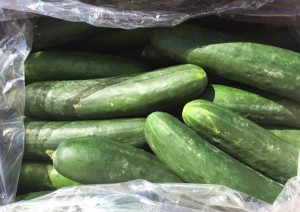A 35-state cucumber Salmonella outbreak includes 40 cases in Wisconsin. The outbreak, which has been linked to cucumbers grown in Mexico and distributed by Andrew & Williamson, includes 732 people, 150 of whom have been hospitalized. Four people have died.
 About 50 percent of the case patients are children under 18, an age group that is at high risk for food poisoning and for serious complications of foodborne infections.
About 50 percent of the case patients are children under 18, an age group that is at high risk for food poisoning and for serious complications of foodborne infections.
Anyone who has eaten cucumbers and has suffered the symptoms of a Salmonella infection, should see a doctor. Because the outbreak strain of Salmonella Poona is not resistant to antibiotics, it will respond to treatment that can help alleviate symptoms and clear the infection. And tests on a stool sample can determine if the illness is part of the outbreak.
Symptoms of salmonellosis include fever, chills, muscle aches, headache, abdominal cramps, nausea, vomiting, and diarrhea that may be bloody. After initial symptoms resolve, long term complications are possible including reactive arthritis, which causes eye irritation and painful swelling of the joints; irritable bowel syndrome, and heart problems.
Two recalls have been issued since the outbreak began. The first on September 4, 2015 for all Andrew & Williamson Fresh Produce sold under the “Limited Edition” brand label. The second on September 11, 2015 by Custom Produce Sales for all cucumbers sold under the Fat Boy label.
The recalled cucumbers are dark green, about 7 to 10 inches long and about 1.75 to 2.5 inches in diameter. They are sold as “slicer” or “American” cucumbers. At grocery stores, they were sold in bulk bins without any identification marks or codes. At restaurants, including Red Lobster locations in Minnesota, they were served sliced on salads.
The Centers for Disease Control says it is not unusual for cases to be reported after a recall. And cucumbers have a shelf life of about two weeks. So people who purchased cucumbers on September 11 and ate them two weeks later would no have become ill until the end of September. It then takes time to see a doctor, submit a stool sample, and receive the lab analysis of that sample that determines if there is a foodborne infection and if it is related to the outbreak.
Case patients, who range in age from less than 1 year to 99, reported onset of illnesses dates ranging from July 3, 2015 to September 25, 2015. Fifty-five percent are female. The median age is 17.
By state that case count is as follows: Alabama (1), Alaska (14), Arizona (114), Arkansas (11), California (192), Colorado (18), Hawaii (1), Idaho (24), Illinois (9), Indiana (3), Iowa (6), Kansas (2), Kentucky (1), Louisiana (5), Maryland (1), Minnesota (37), Missouri (11), Montana (14), Nebraska (6), Nevada (14), New Mexico (31), New York (6), North Dakota (6), Ohio (2), Oklahoma (12), Oregon (20), Pennsylvania (2), South Carolina (9), South Dakota (3), Texas (34), Utah (53), Virginia (1), Washington (22), Wisconsin (40), and Wyoming (7).




